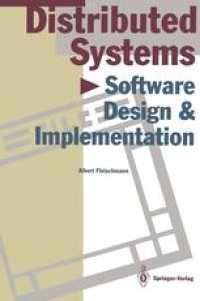
Ebook: Distributed Systems: Software Design and Implementation
Author: Albert Fleischmann (auth.)
- Tags: Software Engineering, Computer Communication Networks
- Year: 1994
- Publisher: Springer-Verlag Berlin Heidelberg
- Edition: 1
- Language: English
- pdf
The purpose of this book is to make the reader famliar with software engineering for distributed systems. Software engineering is a valuable discipline in the develop ment of software. The reader has surely heard of software systems completed months or years later than scheduled with huge cost overruns, systems which on completion did not provide the performance promised, and systems so catastrophic that they had to be abandoned without ever doing any useful work. Software engi neering is the discipline of creating and maintaining software; when used in con junction with more general methods for effective management its use does reduce the incidence of horrors mentioned above. The book gives a good impression of software engineering particularly for dis tributed systems. It emphasises the relationship between software life cycles, meth ods, tools and project management, and how these constitute the framework of an open software engineering environment, especially in the development of distrib uted software systems. There is no closed software engineering environment which can encompass the full range of software missions, just as no single flight plan, airplane or pilot can perform all aviation missions. There are some common activities in software engi neering which must be addressed independent of the applied life cycle or methodol ogy. Different life cycles, methods, related tools and project management ap proaches should fit in such a software engineering framework.
The book provides an introduction to software engineering for distributed systems. Concepts which are essential for the development of distributed programs are described in detail. It is shown how methods of software engineering for both non distributed and distributed programs can be combined in order to use the advantages of all these methods. The result is called "subject oriented programming". It combines asynchronous parallel processes, i.e. threads and object oriented concepts. This hybrid approach makes it easier to design and implement distributed software systems and therefore increases the efficiency of the software engineering process. The reuse of existing software in order to protect software investment is also considered in "subject orientedprogramming".
The book provides an introduction to software engineering for distributed systems. Concepts which are essential for the development of distributed programs are described in detail. It is shown how methods of software engineering for both non distributed and distributed programs can be combined in order to use the advantages of all these methods. The result is called "subject oriented programming". It combines asynchronous parallel processes, i.e. threads and object oriented concepts. This hybrid approach makes it easier to design and implement distributed software systems and therefore increases the efficiency of the software engineering process. The reuse of existing software in order to protect software investment is also considered in "subject orientedprogramming".
Content:
Front Matter....Pages i-xviii
Front Matter....Pages 1-1
Introduction to Distributed Systems and Distributed Software....Pages 3-19
Software Engineering....Pages 21-33
Classification of Software System Types....Pages 35-44
Software Life Cycles....Pages 45-55
Methods: Concepts....Pages 57-101
Methods for Concurrent Software System Development....Pages 103-150
The Management of Software Development....Pages 151-178
Tools....Pages 179-197
Front Matter....Pages 199-199
Overview....Pages 201-213
Decomposing a System....Pages 215-232
Process Communication and Synchronisation....Pages 233-240
Process Behaviour....Pages 241-262
Refinements of a Process....Pages 263-275
Implementation of SAPP/PASS Specifications....Pages 277-292
SAPP/PASS Based Project Management....Pages 293-305
PASS Based Computer Aided Software Engineering....Pages 307-330
A SAPP/PASS Based Software Engineering Environment....Pages 331-348
SAPP/PASS Applications and Experiences....Pages 349-363
Discussion of SAPP/PASS....Pages 365-373
Back Matter....Pages 375-390
The book provides an introduction to software engineering for distributed systems. Concepts which are essential for the development of distributed programs are described in detail. It is shown how methods of software engineering for both non distributed and distributed programs can be combined in order to use the advantages of all these methods. The result is called "subject oriented programming". It combines asynchronous parallel processes, i.e. threads and object oriented concepts. This hybrid approach makes it easier to design and implement distributed software systems and therefore increases the efficiency of the software engineering process. The reuse of existing software in order to protect software investment is also considered in "subject orientedprogramming".
Content:
Front Matter....Pages i-xviii
Front Matter....Pages 1-1
Introduction to Distributed Systems and Distributed Software....Pages 3-19
Software Engineering....Pages 21-33
Classification of Software System Types....Pages 35-44
Software Life Cycles....Pages 45-55
Methods: Concepts....Pages 57-101
Methods for Concurrent Software System Development....Pages 103-150
The Management of Software Development....Pages 151-178
Tools....Pages 179-197
Front Matter....Pages 199-199
Overview....Pages 201-213
Decomposing a System....Pages 215-232
Process Communication and Synchronisation....Pages 233-240
Process Behaviour....Pages 241-262
Refinements of a Process....Pages 263-275
Implementation of SAPP/PASS Specifications....Pages 277-292
SAPP/PASS Based Project Management....Pages 293-305
PASS Based Computer Aided Software Engineering....Pages 307-330
A SAPP/PASS Based Software Engineering Environment....Pages 331-348
SAPP/PASS Applications and Experiences....Pages 349-363
Discussion of SAPP/PASS....Pages 365-373
Back Matter....Pages 375-390
....